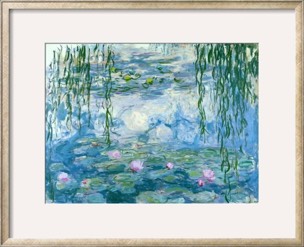Not Just a Pretty Picture:
5 Facts About the Impact of Art in the Workplace
Funny thing: Out-of-the-box thinking doesn't happen in a box.
Leonardo Da Vinci, Albert Einstein and Wolfang Amadeus Mozart didn't produce their best work in gray, fabric-lined cubicles. Not only are these spaces physically constrictive, but they—by their very nature—cramp the birth of new ideas.
That's why, at least in Corporate America, that old sea of uninspired cube farms is slowly giving way to open, collaborative work spaces full of art and expression. For many of you, this seismic shift will resonate on emotional level. But, others will want to see data to back up the notion that an energetic Jackson Pollock or engulfing Georgia O'Keeffe framed art print has any bearing on productivity, creativity and overall worker satisfaction. This is for you.

Georgia O'Keeffe, Red Canna
1. Art boosts productivity
While it's not 100% clear why art stimulates employees to work harder and smarter, prestigious universities around the world have shown it to be true. Subjects in an Exeter study were asked to do an hour of work in four different environments ranging from the bare basics to an enhanced workplace with art and plants. The result: Employees worked 15% quicker in enhanced environments. And, they were 32% more productive if they also had personal input on the art in their surroundings.

Jackson Pollock, No.9
2. Art stimulates creativity
Seeing things from another person's perspective can pull you out of a creative rut. Say you're an employee on your way to the water cooler.
You've been thinking about a problem one way for hours. You have tunnel vision. Then, in the hallway you pass a framed photographic print. Something shifts in your brain and you see a completely different side of your dilemma. You've just experienced an instance of art stimulating creativity and, in effect, changing your mind.

Thomas Barbey, Swell Time in Town
3. Art reduces stress
You don't need cold, hard facts to wrap your head around how a tropical Henri Rousseau or glimpse of Monet's famed Water Lilies might have a calming effect on the psyche, not to mention the power to change your physiology (think lower blood pressure), but here's some data anyway. According to Forbes, 78% of respondents in a survey of over 800 employees working for 32 U.S companies claimed that art in the workplace helped reduce their stress.
Hello, mental vacation.

Claude Monet, Water Lilies
4. Art enhances communication
Findings from a Harvard University study reveal that because art elicits an emotional response, it can pave the way to more open communication and interpersonal connections in the workplace.
This will become increasingly critical as more Millennials (the under 30 crowd) enter the workforce. Because, studies show that technology and social media are making the largest generation entering the U.S. labor force, less social.

New Yorker Cartoon, Man at Bar
5. Art speaks volumes about your company
According to a survey conducted by a workplace design consultancy firm, 83% of employees claimed that artwork was important in the work environment. However, think beyond aesthetics. If a picture is worth a thousand words, carefully consider what your walls convey. If they're bare, the message might be “we haven't quite got our act together.” On the other hand, if they're vibrant and lined with evocative, richly-hued art, they might say “we're smart and dynamic.” You get the picture.
Some of you might be thinking, “you had me at 32% more productive.” That's clearly a management win. However, based on these facts, it's evident that art can color everything about a business, from employee well-being to how connected individuals feel within an organization. Take all the facts into consideration as you embark on a crusade to canvas your business' walls.
If you're not sure where to start, consult the business art experts of Art.com's WorkspaceArt division.

Cory Silken, April 20 (limited edition)